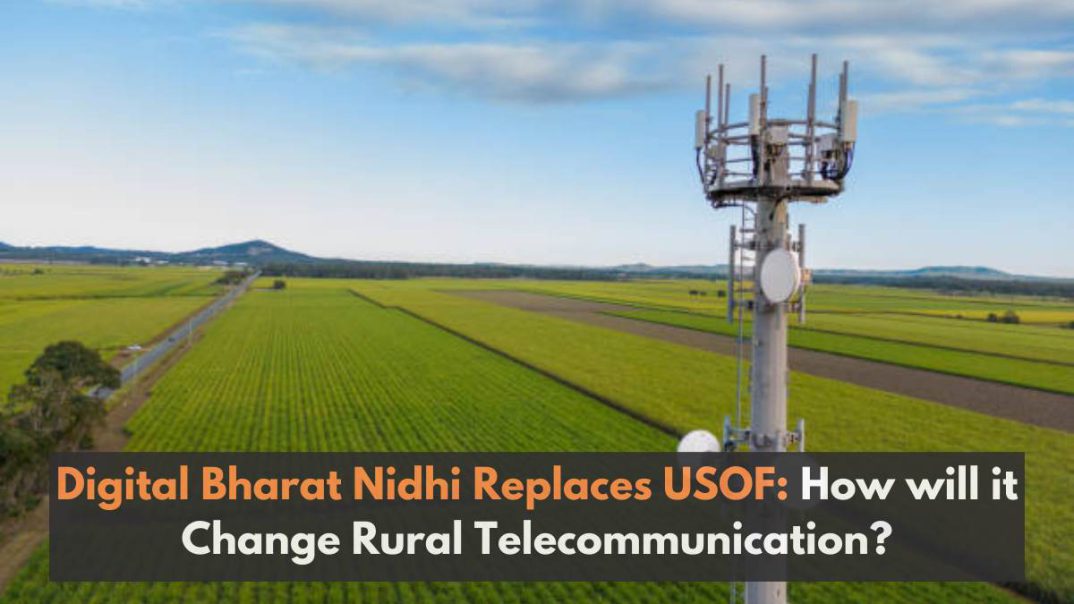In an effort to improve telecom connectivity in rural areas, the central government has undertaken a new project: the Digital Bharat Nidhi. On July 4, the Department of Telecommunications (DoT) issued draft rules to put this project into action.
The Digital Bharat Nidhi will replace the Universal Service Obligation Fund (USOF). Previously, the USOF was funded by a five percent Universal Service Levy imposed on the Adjusted Gross Revenue (AGR) of all telecom operators.
Why was it Needed?
The plan is to use this money to expand telecom networks in remote and rural areas, where private companies might avoid offering services because these areas don’t generate much revenue.
With the recent notification of parts of the Telecom Act, the government has also proposed new rules for transforming the USOF into the Digital Bharat Nidhi (DBN), which will have a broader scope than the USOF.
What is Digital Bharat Nidhi?
The Digital Bharat Nidhi aims to ensure universal and easy access to telecom services in underserved regions. It will also fund research and development in telecom technologies, support pilot projects, and introduce new and innovative telecom services and products.
What is the Plan?
Telecom companies’ contributions to the Digital Bharat Nidhi (DBN) will first be directed to the Consolidated Fund of India (CFI) according to the Telecom Act. The CFI contains all government revenue, including funds from loans and repayments. The government uses these funds for its expenses.
From time to time, the government will transfer the accumulated funds to the DBN. The money in the DBN will be used for various purposes, including:
- Assisting in the creation of new telecom services, technologies, and goods
- Supporting pilot projects
- Providing consulting services and advisory support to improve connectivity
- Introducing new telecommunication services, technologies, and products
- Improving the availability and accessibility of telecommunication services in neglected urban, rural, and remote areas
How will DBN Work?
According to the proposed guidelines from the Department of Telecommunications (DoT) on operationalizing the Digital Bharat Nidhi (DBN), the government will appoint an “administrator” responsible for selecting “DBN implementers” through applications or bidding processes.
The administrator will decide on various financing options for DBN implementers, including full funding, partial funding, co-funding, market risk mitigation, and providing risk capital.
Under the draft guidelines, the DBN aims to fund programs and initiatives that provide targeted access to telecommunication services for marginalized groups, including women, people with disabilities, and economically and socially disadvantaged communities.
Who Will Benefit from DBN?
The schemes and projects under the DBN are designed to benefit underserved rural, remote, and urban areas by introducing next-generation telecommunication technologies and improving the affordability of these services. The DBN aims to promote innovation, research and development, and the commercialization of indigenous technologies, including the creation of regulatory sandboxes. It also focuses on developing and establishing national and international standards and encouraging start-ups in the telecommunications sector, including telecom equipment manufacturing.
According to the draft rules, “Any DBN implementer receiving funding must share and provide access to their telecommunication network and services on an open and non-discriminatory basis, and in accordance with the instructions issued from time to time by the administrator.”
This ensures that the benefits of improved telecommunication infrastructure and services reach a wide range of users, including women, people with disabilities, economically and socially disadvantaged groups, and start-ups in the telecommunications sector.
Why was USOF Replaced?
Since its start in 2003, the USOF has often been criticized for being underused.
- Former Minister of State for Communications Devusinh Chauhan shared in December 2022 that between 2017 and 2022, the government collected Rs 41,740 crore from telcom companies for the USOF. Out of this, only Rs 30,213 crore, or about 72%, was utilized.
- In 2019-20, the government collected Rs 7,962 crore, but only used Rs 2,926 crore.
- The government never achieved full utilization of the funds during the period mentioned by the former minister.
|
Year |
Collected (Rs. crore) |
Utilized (Rs. crore) |
Utilization Rate |
|
Total (2017-2022) |
41,740 |
30,213 |
72% |
|
2019-20 |
7,962 |
2,926 |
37% |
Moreover, in FY23, the government revised its expenditure estimates from Rs 9,000 crore to Rs 3,010 crore, a reduction of 200%.
One key reason for the low spending was the underutilization of funds designated for the BharatNet project, which is designed to deliver fiber connectivity to villages.




